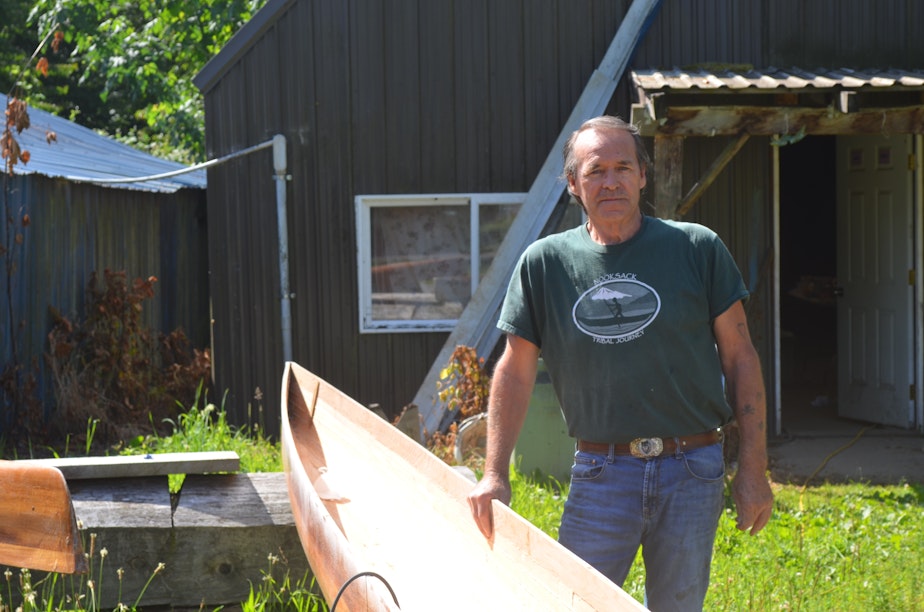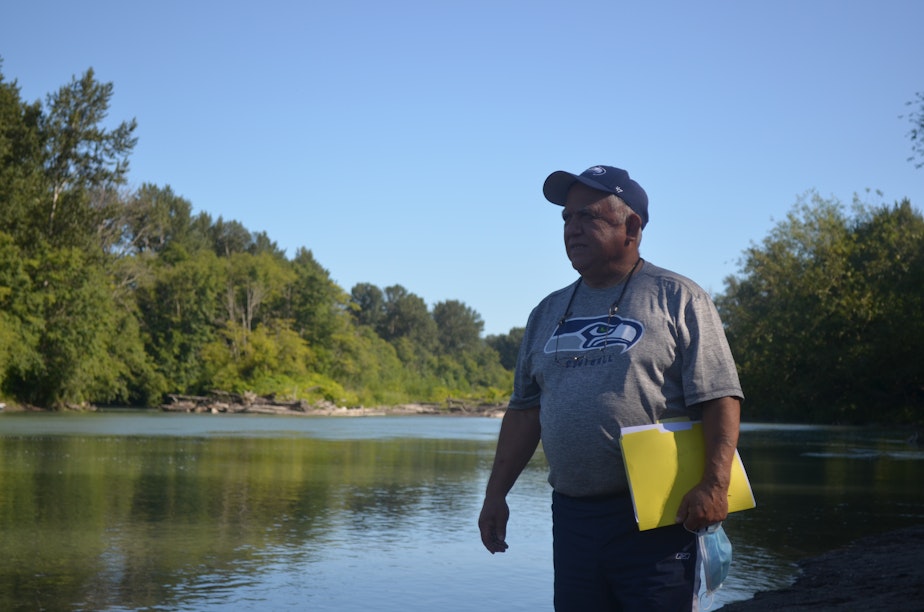60-year-old Nooksack dam is being blasted to pieces to let fish swim free
The dam blocking the Middle Fork of the Nooksack River in northern Washington is pretty small -- as dams go. It’s in a deep gorge, with 100-foot canyon walls on either side.
Right now, there’s no water flowing through the dam itself. Crews have diverted the river to run along the other side of the canyon. That’s so they can plant dynamite and blast the dam to pieces.
Once the crews have finished their work, the dam will be gone. Chinook salmon and other fish will be able to travel to the river’s upper reaches for the first time in nearly 60 years.
The Nooksack Dam removal is the latest effort to take out dams throughout the Pacific Northwest — and this one is being taken out thanks in part to the efforts of George Swanaset Sr., a member of the Nooksack Tribe.
Swanaset, 74, is retired, so he spends most of his time building racing canoes.
“This is my new dugout, out of one piece of cedar,” he said as he walked around a large workshop with at least a dozen canoes.
“There is a bunch in here,” he said. “I don’t know what you call them — a fleet? This is my grandson’s canoe; it’s called Lone Star.”
Sponsored
Swanaset grew up on the Nooksack River.
“My first remembrance of the river — I was quite little,” not quite five years old, he said. “Mom and dad were going down the river [to] do some dip-netting — catching fish.”
The water scared him, Swanaset remembers.
Even so, he said, “My dad introduced me to the water — picked me up and dropped me in the water and says, ‘Swim.’”
Swanaset said he’s been on the river constantly ever since.
Sponsored
“It’s our — how do you say — our blood line that sustains us,” he said. “We get our food from the river. We get our cultural healing from the river. We travel on the water.”
Swanaset was 16 years old when the city of Bellingham dammed up the river in the foothills of the North Cascades to divert water for industry and homes.
Ever since, Swanaset’s been working to get the dam taken out.

And, now, with $18 million in public and private funding, it’s finally happening.
Bellingham will still get some water from the river with a diversion mechanism that doesn’t block the channel.
Sponsored
Swanaset said he’s concerned the city will take too much water out, and the water that’s left won’t be cold enough for fish.
But April McEwen, who’s overseeing the dam removal for the non-profit American Rivers, said Bellingham won’t divert too much water, because the Nooksack’s just a back-up source.
“Folks sort of pitch ‘fish vs people’ or ‘the environment vs people,’ and that doesn’t have to be the case,” she said. “You can have your drinking water supply with much less environmental impact.”

Far downriver from the dam, close to where the Nooksack River drains into Bellingham Bay, there’s a sand spit on the Lummi Nation’s territory.
Merle Jefferson, a Lummi member and the tribe's director of natural resources, said this spit didn’t used to be here.
Sponsored
“This river used to be really, really, really deep,” he explained.
Jefferson said he used to fish full-time, but there aren’t enough fish left for that.
“This is a fishing village where I stayed as a small boy, and this is where my dad fished and my grandpa fished,” he said. “Fishing is very important to Lummi Nation.”
With the dam gone, steelhead and spring Chinook will be able to migrate to spawning grounds upstream.
And populations of threatened bull trout that live above and below the dam will be able to reunite.
Sponsored
“The conditions of the upper watershed are very intact,” said Rich Carlson, a biologist and habitat restoration ecologist with the Washington Department of Fish and Wildlife.
“It’s a pretty good clean water system, which is what bull trout need. They need clean, cold water.”
Carlson said his agency will work with the Lummi and Nooksack to monitor how the fish are doing.
As for Swanaset, the Nooksack canoe builder, he says he’s happy the river will run free again. He’s looking forward to taking his grandkids and great-grandkids out on the water.
“I just like going fishing,” he said. “It’s sitting down at the river, close to the water, listening, and close my eyes and imagining our people coming up the river.”




